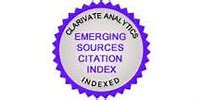Lectura extensiva y lecturas graduadas en lengua inglesa. Análisis comparativo de los diferentes sistemas de clasificación Extensive reading and English graded readers. Analysis of different systems of classification
DOI:
https://doi.org/10.17398/1988-8430.24.1.251Keywords:
lectura extensiva, libros graduados, criterios, sistemas de clasificación.Abstract
Resumen:Las lecturas intensiva y extensiva siguen siendo dos de las prácticas didácticas orientadas hacia la mejora de la comprensión; esta última, frecuentemente con la ayuda de libros graduados que en principio se consideran como un medio de adaptarse a la competencia lingüística del estudiante y sus necesidades. Sin embargo los criterios utilizados por las grandes editoriales para la clasificación no siempre son coherentes. Además, la disposición generalizada de internet y los materiales digitales aconsejan al profesor el uso de criterios variados, puesto que materiales auténticos o textos destinados al aprendizaje del inglés como primera lengua (L1) están disponibles para su uso con estudiantes de inglés como segunda lengua (L2) o lengua extranjera (ILE). Una combinación de criterios nos dará una perspectiva más completa para la elección de libros graduados.
Abstract: Intensive and extensive reading remain two of the teaching practices aimed at improving comprehension; the latter, often with the help of graded books initially considered as a means of adapting to the students’ linguistic competence and their needs. However, the criteria used by the big publishers for the classification are not always consistent. Furthermore, the widespread availability of the internet and digital materials advise the teacher to use a variety of criteria, since authentic materials or texts for learning English as a first language (L1) are available to be used with learners of English as a second language (L2) or as a foreign language (EFL). A combination of criteria will give us a more complete picture for choosing graded books.
References
Referencias bibliográficas
Beaver, J. M. (2006). Developmental Reading Assessment (Teacher's guide K-3). New York: Celebration Press.
Bell, K. (2011). How ESL and EFL classrooms differ. Obtenido 30 de octubre 2014, desde http://oupeltglobalblog.com/2011/07/12/how-esl-and-efl-classrooms-differ/.
Black Cat (2015). Black Cat Readers for ELT. Obtenido 28 de julio 2015, desde http://www.blackcat-cideb.com.
Brewster, J. y Girard, D. (1992). The Primary English Teacher’s Guide. London: Penguin books.
Bright, J.A. y McGregor, G.P. (1970). Teaching English as a second language. London: Longman.
Cambridge University Press (2015). Cambridge English Readers. Obtenido 29 de junio 2015, desde http://www.cambridge.org/us/cambridgeenglish/.
Claridge, G. (2012). Graded readers: How the publishers make the grade. Reading in a Foreign Language, 24(1), 106–119.
Clarity, M. (2007). An Extensive Reading Program for Your ESL Classroom. The Internet TESL Journal, XIII(8). Obtenido 3 de mayo 2015, desde http://iteslj.org/.
Day, R. R., Y Bamford, J. (1998). Extensive reading in the second language classroom. Cambridge: Cambridge University Press.
Day, R. R., Y Bamford, J. (2002). Top ten principles in teaching extensive Reading. Reading in a Foreign Language, 14, 136–141.
Dra2 (2011). Technical manual. Obtenido 1 de febrero 2015, desde http://assets.pearsonschool.com/asset_mgr/current/20139/DRA2_Technical_ Manual_2012.pdf/.
Extensive Reading Foundation (2011). Graded Reader Scale. Obtenido 18 de mayo 2015, desde http://erfoundation.org/wordpress/graded-readers.
Fountas, I.C. y Pinnell, G.S. (1996). Guided Reading. Portsmouth: Heinemann.
Fountas, I.C. y Pinnell, G.S. (2001). Guiding readers and writers grades 3–6: teaching comprehension, genre, and content literacy. Portsmouth: Heinemann.
Fountas, I.C. y Pinnell, G.S. (2008). Benchmark Assessment System 1 and 2. Portsmouth: Heinemann.
Fountas, I.C. y Pinnell, G.S. (2011). Leveled Intervention Systems y The Continuum of Literacy Learning. Grades K-8. Portsmouth: Heinemann.
Grabe, W. (2009). Reading in a second language: Moving from theory to practice, Cambridge: Cambridge University Press.
Grabe, W. (2011). Extensive reading: Why isn’t everyone doing it? En The First Extensive Reading World Congress, Kyoto Japan. Obtenido 4 de febrero 2015, desde https://www.youtube.com/watch?v=qYPYg6mP5_Y/.
Green, J. y Oxford, R.L. (1995). A closer look at learning strategies, L2 proficiency, and gender. TESOL Quarterly, 29, 261-297.
Grenier, S., Jones, S., Strucke, J., Murray, S., Gervais, G. y Brink, S. (2008). Learning literacy in Canada: Evidence from the international survey of reading skills. Ottawa: Statistics Canada. Obtenido 6 de enero 2015, desde http://www.statcan.gc.ca/pub/89-552-m/89-552-m2008019-eng.pdf/.
Griswold, W. y Wright, N. (2004). Wired and well–read. En Philip N. Howard, y S. Jones (Eds.), Society online: The Internet in context, Chapter 13 (pp. 203–222). Thousand Oaks, CA: Sage.
Hafiz, F.M. y Tudor, I. (1989). Extensive reading and the development of language skills. ELT Journal, 43 (1), 4-13.
Harmer, J. (1998). How to Teach English. Edinburgh: Longman.
Hill, D. R. (1992). Edinburgh Project on Extensive Reading. Guide to organising programmes of extensive Reading. Obtenido 6 de marzo 2015, desde https://s3-ap-northeast-1.amazonaws.com/ercentral-website-staticdata/wp-content/uploads/EPER-Guide-1992.pdf/.
Hill, D. R. (2008). Graded readers in English. ELT Journal, 62(2), 184–204.
Karlin, O. y Romanko, R. (2008). Student clustering in an ER program. En K. Bradford Watts, K., T. Muller, y M. Swanson (Eds.), JALT 2007 Conference Proceedings, 997-1010. Obtenido 22 de diciembre 2014, desde http://jalt-publications.org/archive/proceedings/2007/E121.pdf/.
Kirchnoff, C. (2013). L2 extensive reading and flow: Clarifying the relationship. Reading in a Foreign Language, 25(2), 192–212.
Larraz, R. (2014). Lecturabilidad y legibilidad, dos aliadas de la comprensión lectora. Cuaderno Intercultural. Obtenido 7 de enero 2015, desde http://www.cuadernointercultural.com/lecturabilidad-legibilidad-comprension-lectora/.
Lexile. (2015). The Lexile Framework for Reading. Obtenido 15 de marzo 2015, desde https://lexile.com/about-lexile/lexile-overview/.
Leu, D. J., Coiro, J., Castek, J., Hartman, D. K., Henry, L. A. y Reinking, D. (2008). Research on Instruction and Assessment in the New Literacies of Online Reading Comprehension. En C. Collins Block y S. R. Parris (Eds.), Comprehension instruction: Research–based best practices (pp. 321–342). New York: Guilford Press.
Lunzer, E. y Gardner, K. (1979). The effective use of Reading. London: Heinemann.
Macmillan (2015). Macmillan Readers. Obtenido 3 de mayo de 2015, desde http://www.macmillanreaders.com/.
Marco Común Europeo de Referencia para las Lenguas (MCERL) (2002). Madrid, Ministerio de Educación, Cultura y Deporte, Subdirección General de Cooperación Internacional. Obtenido 5 de junio 2015, desde http://cvc.cervantes.es/ensenanza/biblioteca_ele/marco/cvc_mer.pdf/.
Mokhtari, K., Reichard, C. A. y Gardner, A. (2009). The impact of Internet and television use on the reading habits and practices of college students. Journal of Adolescent & Adult Literacy, 52(7), 609–619.
Nation, I. S. P. (2001). Learning vocabulary in another language. Cambridge: Cambridge University Press.
Nation, I. S. P. (2003). The role of the first language in foreign language learning. Asian EFL Journal, 1-8. Obtenido 17 de abril 2015, desde http://www.asian-efljournal.com/june_2003_pn.pdf?origin=publication_detail.
Oxford University Press (OUP) (2015). Graded Readers. Obtenido 29 de abril 2015, desde https://elt.oup.com/teachersclub/subjects/gradedreading/.
Paulston C.B, y Bruder, M.N. (1976). Teaching English as a second language: Techniques and procedures. Cambridge, MA: Winthrop.
Pearson (2015). Pearson English Readers. Obtenido 6 de febrero 2015, desde http://www.penguinreaders.com.
Raz-Kids (2015). Leveled books. Obtenido 3 de junio 2015, desde http://www.raz-kids.com/.
Reading Recovery (2015). Reading Recovery and Common Core. Obtenido 19 mayo 2015, desde http://readingrecovery.org/reading-recovery/.
Renandya, W. (2007). The Power of Extensive Reading. Regional Language Centre Journal, 38, 133–149.
Richmond (2015). Richmond Readers. Obtenido 29 de junio 2015, desde / http://www.richmondelt.com/spain/english/catalogue/supp_graded-readers/default.htm.
Sigaud-Sellos, P. (2010). Aproximación a los conceptos de legibilidad y lecturabilidad: aplicación a la lectura de textos digitales. Pamplona: Universidad de Navarra.
Simensen, A.M. (1987). Adapted readers: How are they adapted? Reading in a Foreign Language, 4, 41-57.
Susser, B. y Robb, T. N. (1990). EFL Extensive Reading Instruction: Research and Procedure. JALT Journal, 12(2). Obtenido 1 de marzo 2015, desde http://www.cc.kyoto-su.ac.jp/~trobb/sussrobb.html/.
Taguchi, E., Takayasu-Maass, M. y Gorsuch, G. J. (2004). Developing reading fluency in EFL: How assisted repeated Reading and extensive reading affect fluency development. Reading in a Foreign Language, 16(2), 70-97.
Takase, A. (2004). Effects of eliminating some demotivating factors in reading English extensively. En M. Swanson y K. Hill (Eds.), JALT 2003 Conference Proceedings (pp. 95–103).
Takase, A (2008). The two most critical tips for a successful extensive reading program”. Kinki University English Journal, 1, 119–136.
Waring, R. (2006). Why extensive reading should be an indispensable part of all language programs. The Language Teacher, 30(7), 44–47.
Widdowson, H. G. (1979). Explorations in Applied Linguistics. Oxford: Oxford University Press.
Downloads
Published
Issue
Section
License

Tejuelo is published with license Creative Commons Reconocimiento-NoComercial-SinObraDerivada 3.0 España.


.jpg)



